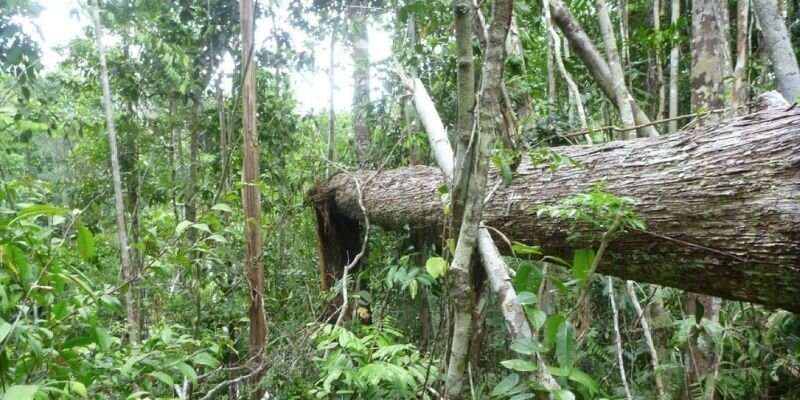Climate change is causing high tree mortality in southern Amazon

A team of Brazilian and British scientists has discovered that extreme wind and water deficiency are the main causes of tree death in the southern Amazon.
The study revealed that more than 70% of all trees dying at the edge of the Amazon rainforest already had severely broken and damaged crowns due to climate change years before they died—a significantly higher percentage than other regions in the Amazon.
Furthermore, the proportion of trees that die broken in this area is more than anywhere else in the Amazon—roughly 54%.
The research published this week in the Journal of Ecology is the first to evaluate large-scale the causes of tree mortality across the southern Amazon rainforest using tree-by-tree data.
Researchers from the University of Leeds, University of Oxford and State University of Mato Grosso (UNEMAT) in Brazil investigated the death of almost 15,000 trees from 19 study plots distributed across remaining forests at the southern edge of the Amazon. The region is the driest, hottest, and most fragmented in the Amazon, and has recently experienced several severe droughts.
Professor Oliver Phillips from the University of Leeds School of Geography, and co-author of the study, said, “Individual trees with low wood density have greatest risk of dying, but such species-level properties do not explain the extreme mortality these forests experience as a whole.
“Rather, the damage caused by climate extremes—especially wind and drought—places exceptional stress on southern Amazon trees.”
Lead author Dr. Simone Matias Reis from UNEMAT said, “Crown breakage hugely increases the risk of tree death. Once broken, the risk of death is much higher, especially when a large part of the tree canopy is broken.
“The growth of broken trees is also affected, as these trees lose capacity to photosynthesize and so take up less carbon, which in turn increases the risk of death.”
Researchers believe that the significant impact of climatic water deficits on mortality is particularly concerning because of climate modeling studies predicting more intense and prolonged seasonality for the Amazon jungle, which may result in high and potentially unprecedented mortality rates for trees of the southern edge region.
Professor Beatriz S. Marimon, the study’s supervisor from UNEMAT, said, “This region already has the highest mortality rates in the whole Amazon region, so determining why trees die here in such numbers is critical.
“The results of our research provide a window onto what the future of large parts of the Amazon may look like if climate change and fragmentation continue to damage the Amazon rainforest.”
Co-author, Professor Ben Hur Marimon from UNEMAT said, “The cumulative effects of tree breakage may be one of the most important components of the Amazon tipping point, beyond which the forest can no longer recover.”
Scientists unravel how and why Amazon trees die
Simone M. Reis et al, Climate and crown damage drive tree mortality in southern Amazonian edge forests, Journal of Ecology (2022). DOI: 10.1111/1365-2745.13849
Citation:
Climate change is causing high tree mortality in southern Amazon (2022, February 28)
retrieved 28 February 2022
from https://phys.org/news/2022-02-climate-high-tree-mortality-southern.html
This document is subject to copyright. Apart from any fair dealing for the purpose of private study or research, no
part may be reproduced without the written permission. The content is provided for information purposes only.
For all the latest Science News Click Here
For the latest news and updates, follow us on Google News.

